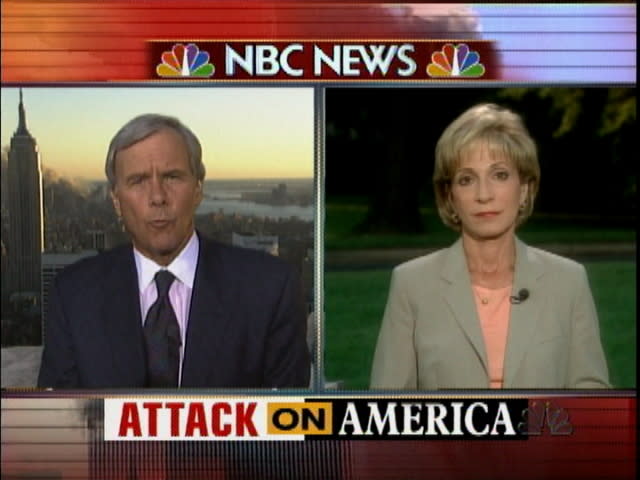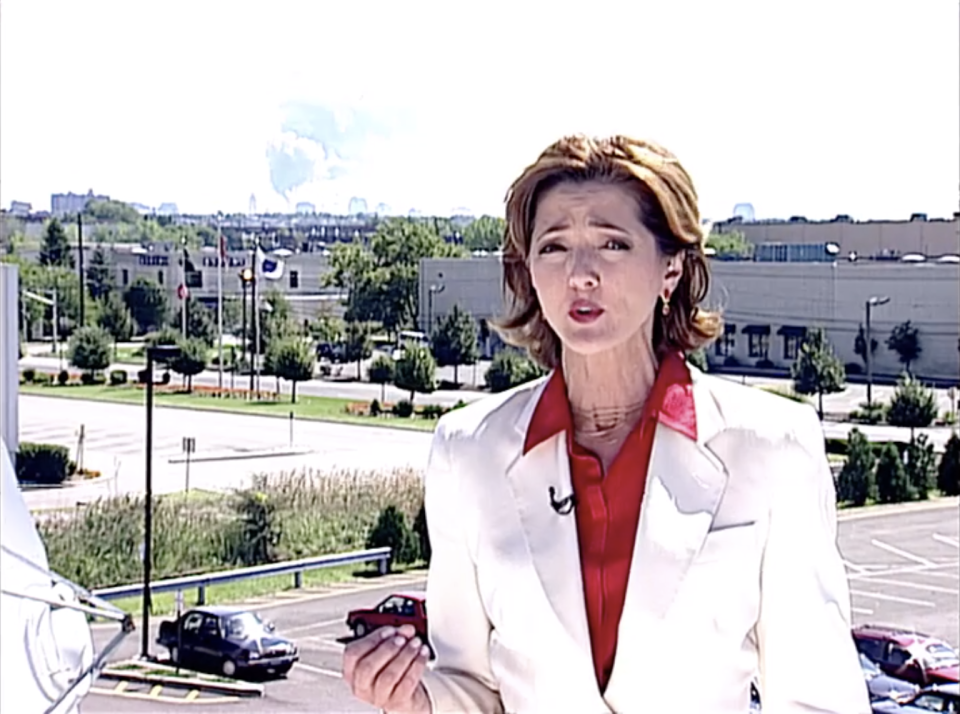The 9/11 Attacks Upended Appointment TV Ushering in the 24/7 News Cycle
- Oops!Something went wrong.Please try again later.
- Oops!Something went wrong.Please try again later.
- Oops!Something went wrong.Please try again later.
- Oops!Something went wrong.Please try again later.

Twenty years ago, on a crystal-clear late summer morning as millions of Americans headed off to work, the era of 24/7 news was born.
Yes, cable news existed before terrorists hijacked four passenger jets and slammed them into the World Trade Center and the Pentagon (while the passengers of Flight 93 staged an uprising against their would-be executioners). CNN had pioneered the round-the-clock news model when it debuted in 1980, and came into its own with wee-hours coverage of 1991’s Gulf War. By 1996, Fox News and MSNBC had entered the market.
More from WWD
But the attacks on Sept. 11, 2001, was the event that upended the news-at-appointed times model that had held sway since the dawn of TV. It was a day when Americans – and the world – could not look away.
At the time, television and radio were the only mass mediums for live news. The internet and “smart phones” existed, but they were far from ubiquitous (or very useful). Social media as we know it today was still decades away. And legacy print outlets had yet to establish robust digital offerings, let alone reliable live video capabilities.
“The 24/7 news cycle was never more percussive than in the aftermath of the attacks,” says Andrea Mitchell, who covered the unfolding event for NBC News.

Courtesy Photo
News organizations began to scramble to understand what was happening after the first plane crashed into the North Tower at 8:46 a.m. Four minutes later, at 8:50 a.m., the first live pictures of smoke pouring out of the North Tower were broadcast. By 8:51 a.m., all three morning shows (NBC’s “Today,” ABC’s “Good Morning America,” CBS’ “The Early Show”) had scrapped their lineups to cover the attacks. The second plane plowing into the south face of the South Tower was broadcast on live television at 9:03 a.m.
“In the absence of social media, cable news, broadcast news became nonstop,” adds Mitchell. “We were on the air for five days with no commercial breaks on all of our networks, from NBC to MSNBC to CNBC, and that’s before streaming. We saw it in front of our eyes. The horror of a building coming down. The people on the planes, the people in the buildings, I knew some of them. A place that was so familiar, New York City, my hometown. And then the Pentagon attack in Washington, where I lived. The evacuation of Congress. The victims and the suffering and the survival and resilience of New York. There’s no way in which it didn’t transform all of our lives collectively.”
The so-called Big Four broadcast networks — ABC, CBS, Fox and NBC — preempted four nights of primetime entertainment programming between Sept. 11 and Sept. 15, 2001, for what The Washington Post characterized at the time as “the longest continuous stream of coverage for a single news story in TV history.”
Mitchell’s husband, then-Federal Reserve chairman Alan Greenspan, was over the Atlantic Ocean, on a flight back to the U.S. from Switzerland, when U.S. airspace was shut down. By the time his plane turned around and landed back in Zurich, it was about 4:30 p.m. in Washington. Mitchell, who was in NBC’s Washington bureau newsroom, heard her phone ring. She answered it just as “Nightly News” anchor Tom Brokaw was about to throw to her from the anchor desk in New York.
“I said, ‘Hi, where are you?’” Mitchell recalls. “And in my ear, I heard the producer saying, ‘Andrea we’re about to come to you.’ All I could say to [Greenspan] was, ‘Listen up’ and I put my old flip cell phone in my lap. And for Tom and for our audience, I reprised everything that happened that day. And that’s how my husband, who was the chairman of the Federal Reserve, found out what was going on.”
On that day — when 2,977 people were killed — Americans were collectively glued to their television sets as pictures of the attacks gave way to video of the smoldering pile at Ground Zero — still on fire days later — and photos of the missing that papered Lower Manhattan. (Of the 2,753 people killed in the Towers, 1,674 have been identified through DNA, the latest only a few days ago.)

Courtesy photo
“This, in the most stunning way, defined what breaking news could be, in the best possible sense,” said Chris Jansing, who was the morning anchor on MSNBC on Sept. 11. On that day, Jansing anchored from the low roof of the network’s Secaucus, N.J., headquarters, which had a view of Lower Manhattan. Over her shoulder, viewers could see the plumes of smoke rising from Ground Zero.
At the time, 90 percent of adults said they got most of their news about the attacks from television, according to a study by the Pew Research Center, while only 5 percent got news online. Television was replete with images of death, grief and destruction. Yet the majority of Americans (63 percent) said they could not stop watching. Nielsen Media Research estimated that 80 million Americans were watching prime-time coverage of the attacks on 9/11.
NBC’s coverage that night averaged more than 22 million viewers from 8 to 11 p.m., while ABC and CBS averaged more than 17 million and 14 million, respectively. We’ll never know precisely how many people were watching the horror unfold that morning. (At the time, Nielsen did not measure out-of-home viewing, and millions of Americans were likely watching the attacks unfold in their offices.) It was hard to watch; in the days immediately following 9/11, 71 percent of adults said they felt depressed, according to Pew, while nearly half had difficulty concentrating and a third reported sleep disruption.
At the time, Jansing was living with her dog in a high-rise apartment along the Hudson River in Manhattan with a view of the Twin Towers. She could not return to her apartment until Sept. 12; by then the Towers were subsumed by flames and acrid smoke. Every morning in the days and weeks afterward, she would wake at 4 a.m. to make the trip to Secaucus to anchor MSNBC’s ongoing coverage.
“It was first of all a privilege, but also a responsibility to do that job and do it well,” she says. “Because I knew how much it mattered. The flames just went on for so long. My morning wakeup was looking out that window and even in the dark being able to see what was left. And saying to myself, ‘Buck up, it’s time to go do the most important thing you’ll ever do professionally.’”
Indeed, out of that horror came a spirit of unity that seems all but impossible today. Then, New York Mayor Rudy Giuliani and former president and first lady Bill and Hillary Clinton stood shoulder-to-shoulder in Yankee Stadium for a memorial service 12 days after the attacks. Today, the ideological chasm is so wide that Americans cannot seem to agree on basic facts — or reality as conspiracy theories have been mainstreamed by social media.
And the media? In November 2001, according to Pew, news organizations enjoyed “record-high ratings for professionalism.” Around seven-in-10 adults (69 percent) said they “stand up for America,” while 60 percent said they protected democracy.
Adds Mitchell: “The news media won’t ever be the same. It accelerated the technological push toward social media, which led to the creation of the platforms for which we are now working. The pandemic should not be underestimated as a transforming event given the unspeakable loss. But in many other ways, 9/11 has not at all faded. And I do hope that these memorials remind people of the sacrifice and the loss and the sense of community in which we all came together.”
Launch Gallery: Twenty Years Later: Remembering September 11th
Sign up for WWD's Newsletter. For the latest news, follow us on Twitter, Facebook, and Instagram.

